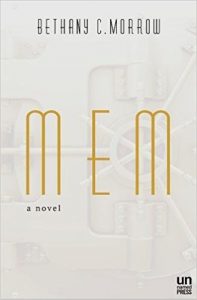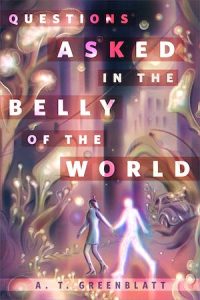Year in Review by Katharine Coldiron

By the time the clock hits 11:59 on December 31, my list of books read for 2018 will tally about 150. Because I review a wide variety of books, a small minority of those books will have been SF/F (only about a dozen, in fact). I like reading and reviewing genre books, and I especially like doing so for Locus, but it’s just a sliver of what I do as a critic. The other excellent critics in these pages will have better ideas about trends in genre fiction this year, and a longer list of what to read, than I do. And that’s fine. Being an omnireader means I’m not an expert on any literature in particular except what is good.
I approached this article with the goal of summarizing the best genre books I read this year, a list which narrows to only three titles. I hope that means that my favoring these three carries more weight, because they are knockouts, all of them, and ought to be widely read.
Shelley Jackson’s Riddance seemed to appear and then disappear in a blink, when books I found mediocre and unoriginal were promoted for months on end. Shelley Jackson has a cult following, I understand, so perhaps it was fated that Riddance would not be surrounded by buzz and hype, but would instead vanish, only to pop up in interviews and on reading lists in the future instead of the present. Still, it’s an extraordinary book, unlike anything I’ve ever read. To tell its surprising, dark, unlovely tale, it uses strange photographs, sourced mysteriously; a series of personal narratives from the thick of the spiritualist movement of the late 19th century; and false texts, from the tradition of Gothic novels told through “found” diaries and other invented materials. Women’s stories, from witchcraft to spinsterism to the devious ways that women seize power, brew potently within it. Riddance is a beautifully made object, both in physical texture and in narrative; it’s too weird to be dull, too dull to be sensational. Its characters are fascinating, unlovable, and ambitious, and its supernatural elements are so complex they call up such famous head-scratchers as Mark Z. Danielewski’s House of Leaves. I can’t say I enjoyed every minute of reading it, but I doubt I will read another book like it in the foreseeable future, and that has to be worth a best-of-the-year mention.
Rebecca Roanhorse’s Trail of Lightning is, if I can be so bold, a perfect urban fantasy novel. It’s told compellingly, realized flawlessly, populated diversely, unfolded tantalizingly. Plus, the dialogue is terrific and the characters are as well-rounded as geometric spheres. I didn’t know what so many other urban fantasy novels were missing until I read it. I burned and ached and laughed with Maggie Hoskie, wanted her by my side and wanted to be her. I haven’t felt like that about a heroine since Kill Bill. The supernatural elements have resonance and foundation so deep and rich it’s unimpeachable, and the apocalypse that spurs the events of the book– white people battling over water until they drown themselves in it – seems all too realistic. Every element a writer wants to incorporate to keep the reader hooked, pursuing the narrative anywhere it goes, is present in Trail of Lightning. I yearn, pitifully, howling in the direction of Roanhorse’s publisher, for the next book in the Sixth World series.
 Bethany C. Morrow’s Mem is a shimmering, elegiac book, much slimmer than the weight of its ideas and much finer than a debut novel has any business being. It delves into the meaning of memory, the full implications of personhood, the capacity of negative experiences to shape human life, and the power of storytelling as a means of survival. As I was reading it, I kept thinking of The Giver, a book often assigned in secondary school, but which I read in graduate school as a window on literary theory. The sense in The Giver of its setting as a proving ground for the author’s ideas also existed in Mem. In both books, the world was well-depicted, but, nevertheless, it felt theoretical rather than tangible. Both books share a persistent thread of sorrow, and both offer a narrator with whom the reader sympathizes instinctually. Because both books are primarily novels of ideas, and because Mem‘s dissection of personhood works so well as a metaphor for racial inequality, they strike me as equally useful books to put in school curricula. Lowry may have been depicting Plato’s Republic when she wrote The Giver, but Morrow’s work in Mem shaves much closer to real social problems than the intellectual exercises of Lowry’s. That makes it perhaps even more useful as a teaching tool. Even if I didn’t think it was a wonderful book for schoolkids, I’d still think it was a wonderful book for the general reading population. It’s deep and wide, and yet still brief and beautiful.
Bethany C. Morrow’s Mem is a shimmering, elegiac book, much slimmer than the weight of its ideas and much finer than a debut novel has any business being. It delves into the meaning of memory, the full implications of personhood, the capacity of negative experiences to shape human life, and the power of storytelling as a means of survival. As I was reading it, I kept thinking of The Giver, a book often assigned in secondary school, but which I read in graduate school as a window on literary theory. The sense in The Giver of its setting as a proving ground for the author’s ideas also existed in Mem. In both books, the world was well-depicted, but, nevertheless, it felt theoretical rather than tangible. Both books share a persistent thread of sorrow, and both offer a narrator with whom the reader sympathizes instinctually. Because both books are primarily novels of ideas, and because Mem‘s dissection of personhood works so well as a metaphor for racial inequality, they strike me as equally useful books to put in school curricula. Lowry may have been depicting Plato’s Republic when she wrote The Giver, but Morrow’s work in Mem shaves much closer to real social problems than the intellectual exercises of Lowry’s. That makes it perhaps even more useful as a teaching tool. Even if I didn’t think it was a wonderful book for schoolkids, I’d still think it was a wonderful book for the general reading population. It’s deep and wide, and yet still brief and beautiful.
Katharine Coldiron is the author of Ceremonials (Kernpunkt Press), an SPD fiction bestseller. Her work as a book critic has appeared in The Washington Post, The Believer, The Guardian, and many other places. She lives in California and at kcoldiron.com.
This and more like it in the February 2019 issue of Locus.
 While you are here, please take a moment to support Locus with a one-time or recurring donation. We rely on reader donations to keep the magazine and site going, and would like to keep the site paywall free, but WE NEED YOUR FINANCIAL SUPPORT to continue quality coverage of the science fiction and fantasy field.
While you are here, please take a moment to support Locus with a one-time or recurring donation. We rely on reader donations to keep the magazine and site going, and would like to keep the site paywall free, but WE NEED YOUR FINANCIAL SUPPORT to continue quality coverage of the science fiction and fantasy field.







